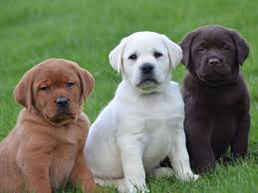Labrador Retriever Puppies for Sale Miami

With the purchase of your puppy:
- 14 days of warranty
- 1 year warranty
- Health Certificate
- Deworming
- Shots- to date
- 1st Vet Visit
- Registration Papers
- Dog Training
The Labrador Retriever is one of several kinds of retriever, a type of gun dog. Even-tempered and well-behaved around young children and the elderly, Labradors are athletic and playful, and are the most popular breed of dog by registered ownership in Australia, Canada, New Zealand, the United Kingdom, and the United States (since 1991). A favourite assistance dog breed in these and other countries, Labradors are frequently trained to aid blind and autistic people, act as therapy dogs, and perform screening and detection work for law enforcement and other official agencies.
History:
The modern Labrador’s ancestors originated on the island of Newfoundland, now part of the province of Newfoundland and Labrador, Canada. The founding breed of the Labrador was the St. John’s water dog, a breed that emerged through ad-hoc breedings by early settlers of the island in the 16th century. The forebears of the St. John’s Dog are not known but were likely a random-bred mix of English, Irish, and Portuguese working breeds. The Newfoundland (known then as the Greater Newfoundland) is likely a result of the St. John’s Dog breeding with mastiffs brought to the island by the generations of Portuguese fishermen who had been fishing offshore since the 16th century. The smaller short-coated St. John’s Dog (also known then as the Lesser Newfoundland) was used for retrieval and pulling in nets from the water. These smaller dogs were the forebears of the Labrador Retriever. The white chest, feet, chin, and muzzle – known as tuxedo markings – characteristic of the St. John’s Dog often appear in modern Lab mixes, and will occasionally manifest in Labradors as a small white spot on the chest (known as a medallion) or stray white hairs on the feet or muzzle.
Appearance:
Labradors are relatively large, with males typically weighing 29 to 41 kg (64 to 90 lb) and females 25 to 32 kg (55 to 71 lb). Labradors weighing close to or over 100 lb (45 kg) are considered obese or having a major fault under American Kennel Club standards, although some Labradors weigh significantly more. The majority of the characteristics of this breed, with the exception of colour, are the result of breeding to produce a working retriever.
As with some other breeds, the Conformation (typically “English”, “show” or “bench”) and the Field (typically “American” or “working”) lines differ, although both lines are bred in both countries. In general, however, Conformation Labradors tend to be bred as medium-sized dogs, shorter and stockier with fuller faces and a slightly calmer nature than their Field counterparts, which are often bred as taller, lighter-framed dogs, with slightly less broad faces and a slightly longer nose; however Field Labradors should still be proportional and fit within AKC standards. With field Labradors, excessively long noses, thin heads, long legs and lanky frames are not considered standard. These two types are informal and not codified or standardised; no distinction is made by the AKC or other kennel clubs, but the two types come from different breeding lines. Australian stock also exists; though not seen in the west, they are common in Asia. These dogs are also very good with children.
Wikipedia
